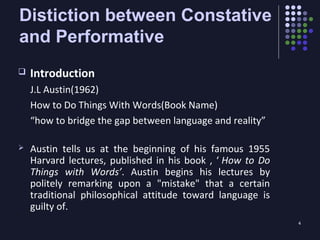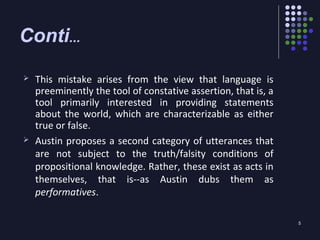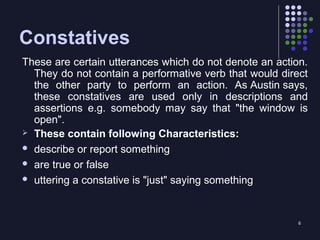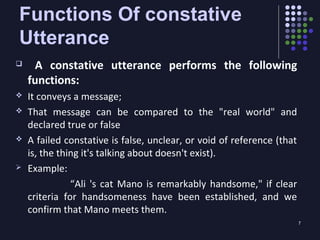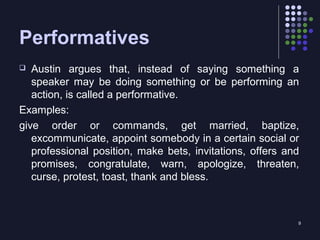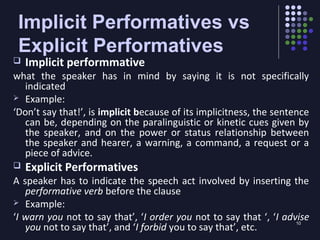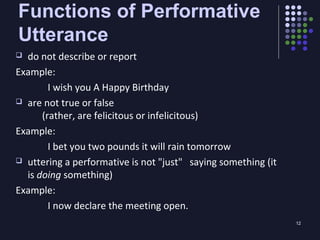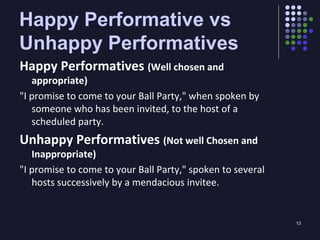- 2. Distiction betweeen
Constative and
Performative
Group-SAA
Shahnawaz shahid
Ali Furqan Syed
Abdul Rauf
Lahore InstItute of future educatIon, Lahore
- 3. 3
Overview
Introduction
Constatives
Functions of Constative Utterence
Problem Constatives
Performatives
Implicit vs Explicit Performatives
Functions of Performative Utterance
Happy Performatives
Unhappy Performatives
Conclusin
References
- 4. 4
Distiction between Constative
and Performative
Introduction
J.L Austin(1962)
How to Do Things With Words(Book Name)
“how to bridge the gap between language and reality”
Austin tells us at the beginning of his famous 1955
Harvard lectures, published in his book , ‘ How to Do
Things with Words’. Austin begins his lectures by
politely remarking upon a "mistake" that a certain
traditional philosophical attitude toward language is
guilty of.
- 5. 5
Conti...
This mistake arises from the view that language is
preeminently the tool of constative assertion, that is, a
tool primarily interested in providing statements
about the world, which are characterizable as either
true or false.
Austin proposes a second category of utterances that
are not subject to the truth/falsity conditions of
propositional knowledge. Rather, these exist as acts in
themselves, that is--as Austin dubs them as
performatives.
- 6. 6
Constatives
These are certain utterances which do not denote an action.
They do not contain a performative verb that would direct
the other party to perform an action. As Austin says,
these constatives are used only in descriptions and
assertions e.g. somebody may say that "the window is
open".
These contain following Characteristics:
describe or report something
are true or false
uttering a constative is "just" saying something
- 7. 7
Functions Of constative
Utterance
A constative utterance performs the following
functions:
It conveys a message;
That message can be compared to the "real world" and
declared true or false
A failed constative is false, unclear, or void of reference (that
is, the thing it's talking about doesn't exist).
Example:
“Ali 's cat Mano is remarkably handsome," if clear
criteria for handsomeness have been established, and we
confirm that Mano meets them.
- 8. 8
Problem Constatives
False Statement
Example:She's the redhead who's missing a tooth." Oops.
She changed her hair color before we made this statement;
the facts render it false.
Unclear Sentences (Not properly confirmed)
Example:"I have forgotten my umbrella," when scrawled on
the margins of a dead philosopher's notes; "That's unfair,"
when it's not clear what "that" is, or why I object to it.
Non existence of referent
Example:"The king of France is bald." The referent--the king
of France--doesn't exist.
- 9. 9
Performatives
Austin argues that, instead of saying something a
speaker may be doing something or be performing an
action, is called a performative.
Examples:
give order or commands, get married, baptize,
excommunicate, appoint somebody in a certain social or
professional position, make bets, invitations, offers and
promises, congratulate, warn, apologize, threaten,
curse, protest, toast, thank and bless.
- 10. 10
Implicit Performatives vs
Explicit Performatives
Implicit performmative
what the speaker has in mind by saying it is not specifically
indicated
Example:
‘Don’t say that!’, is implicit because of its implicitness, the sentence
can be, depending on the paralinguistic or kinetic cues given by
the speaker, and on the power or status relationship between
the speaker and hearer, a warning, a command, a request or a
piece of advice.
Explicit Performatives
A speaker has to indicate the speech act involved by inserting the
performative verb before the clause
Example:
‘I warn you not to say that’, ‘I order you not to say that ‘, ‘I advise
you not to say that’, and ‘I forbid you to say that’, etc.
- 11. 11
Conti...
A short list of performative verbs may comprise:
abolish, accept, acknowledge, acquit, admit, admonish,
advise, affirm, agree to, announce, answer, apologize,
ascribe, ask, assert, assess, assume, authorize, baptize,
beg, bet, bid, caution, charge, christen, claim, classify,
command, commiserate, compliment, concur,
congratulate, convict, counsel, declare, delegate, demand,
deny, describe, diagnose, disagree, donate, dub, excuse,
exempt, fire, forbid, grant, gua rantee, guess, hire etc
- 12. 12
Functions of Performative
Utterance
do not describe or report
Example:
I wish you A Happy Birthday
are not true or false
(rather, are felicitous or infelicitous)
Example:
I bet you two pounds it will rain tomorrow
uttering a performative is not "just" saying something (it
is doing something)
Example:
I now declare the meeting open.
- 13. 13
Happy Performative vs
Unhappy Performatives
Happy Performatives (Well chosen and
appropriate)
"I promise to come to your Ball Party," when spoken by
someone who has been invited, to the host of a
scheduled party.
Unhappy Performatives (Not well Chosen and
Inappropriate)
"I promise to come to your Ball Party," spoken to several
hosts successively by a mendacious invitee.
- 14. 14
Conclusion
In conclusion, we can refer back to our initial suggestion that
performatives are not simply the polar opposite of
constatives. As we have seen, Austin himself took care not to
reduce the two types of speech acts to a simple case of binary
opposition. But Austin's hypothesis, I have argued, is not
radical enough. His performative-constative distinction is
better explained along genetic lines, where the performative
is understood as the condition of possibility for more
specialized constative speech acts.
- 15. 15
References
Austin. J.L. How to Do Things with Words. 1962. 2nd ed.
Cambridge: Harvard UP, 1975.
http://lib.uinmalang.ac.id/files/thesis/fullchapter/05320113.pdf
YULE, G. (1996): Pragmatics, Oxford, Oxford UniversityPress.
ELENA LOPEZ ALVERZ: Performative Speech Act Verbs in Present
Day English, Universidad Complutense de Madrid.
- 16. Thank You….
allah hafiz…
16




